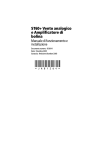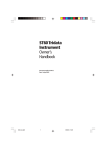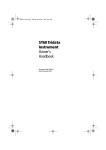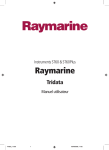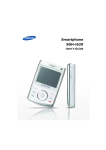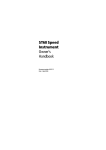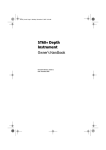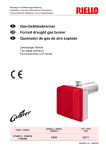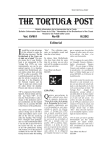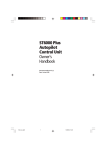Download Raymarine ST60 Installation manual
Transcript
ST60 Wind & Close Hauled Wind Instruments Owner’s Handbook Document number: 81105-3 Date: 1st April 1999 105_3cov.p65 1 06/04/01, 10:46 © Copyright Raymarine Limited 2001 105_3cov.p65 2 06/04/01, 10:46 Introduction i Contents Introduction ............................................................................ v EMC conformance ........................................................... vi ST60 Wind ....................................................................... vi ST60 Close Hauled Wind ................................................. vi Data inputs ....................................................................... vi SeaTalk ....................................................................... vi Stand alone operation ................................................ vii Remote control ................................................................ vii Mounting options ............................................................ vii Parts supplied ..................................................................... viii Chapter 1: Operation ............................................................. 1 1.1 Getting started ............................................................. 1 Calibration requirements ............................................. 1 Displayed information ................................................. 1 Pointer .................................................................... 1 Digital display ....................................................... 2 1.2 Normal operation ........................................................ 2 True/Apparent ............................................................. 4 VMG ........................................................................... 4 Tack ............................................................................. 4 Alarms ......................................................................... 4 Cancelling an alarm ............................................... 4 Setting alarm conditions ........................................ 5 Switching alarms on and off ............................ 5 Setting alarm thresholds .................................. 5 1.3 Display illumination ................................................... 6 1.4 Remote control ............................................................ 6 105_3int.p65 1 06/04/01, 10:46 ii ST60 Wind and Close Hauled Wind Instrument Owner’s Handbook Chapter 2: Maintenance and Fault Finding ........................ 7 2.1 Maintenance ................................................................ 7 Servicing and safety .................................................... 7 Instrument ................................................................... 7 Transducer ................................................................... 7 Cabling ........................................................................ 7 2.2 Fault finding ................................................................ 8 Preliminary procedures ............................................... 8 Fixing faults ................................................................ 8 Chapter 3: Installation ........................................................... 9 3.1 Planning your installation ........................................... 9 Site requirements ......................................................... 9 Transducer ............................................................. 9 Instrument ............................................................ 10 EMC guidelines ......................................................... 11 Suppression ferrites ............................................. 11 Connections to other equipment .................... 12 3.2 Procedure .................................................................. 12 Unpacking ................................................................. 12 Fitting the instruments............................................... 12 Surface mounting ................................................ 13 Flush mounting .................................................... 14 Fitting the low-profile bezel ........................... 14 Flush mounting procedure ............................. 15 Bracket Mounting ................................................ 16 Fitting transducers ..................................................... 16 Typical windvane installation .............................. 17 Rotavecta ............................................................. 18 105_3int.p65 2 06/04/01, 10:46 Introduction iii Running transducer cable .................................... 18 General ........................................................... 18 From masthead ............................................... 19 Connecting the instruments ....................................... 20 Types of connection ............................................. 20 Signal connections ............................................... 21 Power supply connections ................................... 22 SeaTalk systems ............................................. 22 Stand alone instruments ................................. 22 Chapter 4: Calibration ......................................................... 25 4.1 Introduction .............................................................. 25 EMC conformance .................................................... 25 4.2 User calibration ......................................................... 25 Linearising and aligning the wind transducer ........... 25 Leaving User calibration ........................................... 26 4.3 Intermediate calibration ............................................ 27 Leaving Intermediate calibration .............................. 27 4.4 Dealer calibration ...................................................... 27 User calibration on/off .............................................. 28 Response settings ...................................................... 28 Wind speed ................................................................ 28 Boat show mode (bSO) ............................................. 31 Factory reset (FO) ..................................................... 31 Leaving Dealer calibration ........................................ 31 105_3int.p65 3 06/04/01, 10:46 iv 105_3int.p65 ST60 Wind and Close Hauled Wind Instrument Owner’s Handbook 4 06/04/01, 10:46 Introduction v Introduction Thank you for purchasing a Raymarine product. We are sure your ST60 instrument will give you many years of trouble-free operation. This handbook describes how to install and use the Raymarine ST60 Wind and ST60 Close Hauled Wind instruments. These give: • True and Apparent wind direction and speed. Wind speed is displayed either in knots, meters per second or as Beaufort scale values. • Velocity made good (VMG). • Maximum wind speed. In addition to this, ST60 Wind master instruments give: • Maximum minimum true wind speed alarms. • High and low apparent wind angle alarms. ST60 Close Hauled Wind instrument ST60 Wind instrument The ST60 Wind and Close Hauled Wind instruments are constructed in rugged weather proofed cases. Each provides a sensitive and stable, combined analogue and digital display, to deliver accurate information under even the most demanding conditions. WARNING Although the ST60 Wind and Close Hauled Wind instruments are designed to give accurate and reliable performance, they should serve only as an aid to navigation and should never lead to the erosion of good seamanship. Always maintain a permanent watch and be aware of situations as they develop. 105_3int.p65 5 06/04/01, 11:36 vi ST60 Wind and Close Hauled Wind Instrument Owner’s Handbook EMC conformance All Raymarine equipment and accessories are designed to the best industry standards for use in the leisure marine environment. Their design and manufacture conforms to the appropriate Electromagnetic Compatibility (EMC) standards, but correct installation is required to ensure that performance is not compromised. ST60 Wind The ST60 Wind instrument provides a 360o apparent wind scale and can be used either as a stand-alone unit, or as part of an integrated SeaTalk instrumentation system. ST60 Close Hauled Wind The ST60 Close Hauled Wind instrument provides an expanded indication from -60o to +60o about the bow and stern of the boat, on a combined analogue and digital display. Data inputs SeaTalk SeaTalk enables a number of compatible instruments to operate as a single, integrated navigational system. Instruments in a SeaTalk system are linked by means of a single cable, which feeds both power and data. Instruments can therefore be added to the system by plugging them into the network. SeaTalk is flexible enough to adapt to any number of compatible instruments without requiring a central processor. SeaTalk can also communicate via an appropriate interface with non-SeaTalk equipment, using the internationally-accepted National Marine Electronics Association (NMEA) protocol. In a SeaTalk system, each instrument can be either a master or dedicated repeater unit. A master instrument is directly connected to a transducer (the device that provides the raw data), and provides data and control for the service it is providing to all other equipment on the SeaTalk network. A slave instrument is not directly connected to a transducer but repeats information provided by other equipment in the SeaTalk network. 105_3int.p65 6 06/04/01, 11:36 Introduction vii Stand alone operation In Stand alone operation, the ST60 Wind instrument is connected only to the relevant transducer and does not display information from, or provide information to, any other instruments. Note: The ST60 Close Hauled Wind instrument operates only as a SeaTalk repeater. It cannot be connected directly to a wind transducer. Remote control When connected to SeaTalk, the ST60 Wind and Close Hauled Wind instruments can be controlled remotely by a SeaTalk Remote Keypad Unit, to provide instant remote access to the various display readouts. Mounting options If you do not want to surface mount your ST60 instrument, options are available for: • Flush mounting. If you have ordered the flush mounting option a low-profile bezel and four fixing screws are also provided. • Bracket mounting. 105_3int.p65 7 06/04/01, 10:46 viii ST60 Wind and Close Hauled Wind Instrument Owner’s Handbook Parts supplied Unpack your ST60 instrument and check that the following items are present: Either • Item 1a, ST60 Wind instrument, fitted with standard bezel for surface mounting or • Item 1b, ST60 Close Hauled Wind instrument, fitted with standard bezel for surface mounting. • Item 2, • Item 3, • Item 4, Either • Item 5a, or • Item 5b, • • • • • Item 6, Item 7, Item 8, Item 9, Item 10, • Item 11, • Item 12, Fixing studs (2). Thumb nuts (2). Gasket. Wind Vane (not with ST60 Close Hauled Wind) Rotavecta (not with ST60 Close Hauled Wind). SeaTalk interconnection cable. Power cable (not with ST60 Close Hauled Wind). Instrument Cover. Junction Box (not with ST60 Close Hauled Wind). Owner’s Handbook. A Warranty document and fitting templates are included in this Handbook. Worldwide Service Centre Handbook. Cue Card. Spare spade terminals are also provided, to re-terminate transducer cables if they have to be cut to facilitate installation. Note: The above packing list is for an ST60 Wind system. Where an instrument is purchased separately, a transducer and junction box are not included. 105_3int.p65 8 06/04/01, 10:46 Introduction ix 1a 2 3 2 3 1b 4 6 8 These items are not with ST60 Close Hauled Wind 7 5a 9 5b WIND Operation ST60 Wind Instrument Owner's Handbook Worldwide Distributors VMG TACK KTS TRUE APP TRUE APP 3s to reset * * HI * LO 10 12 11 D4442-2 105_3int.p65 9 06/04/01, 10:47 x 105_3int.p65 ST60 Wind and Close Hauled Wind Instrument Owner’s Handbook 10 06/04/01, 10:47 1 Chapter 1: Operation Chapter 1: Operation 1.1 Getting started This handbook describes how to operate, maintain and install the Raymarine ST60 Wind instrument and ST60 Close Hauled Wind instrument. These instruments show: • Wind speeds and directions • Velocity Made Good (VMG) information, when boat-speed information is available, • Tack angle, when heading information is available, Calibration requirements Your ST60 instrument is calibrated to factory (default) settings when first installed and must therefore be calibrated before use, in accordance with the procedures in Chapter 4, Calibration, to ensure optimum performance on your vessel. Do NOT use the instrument until the calibration procedures have been satisfactorily completed. If the CAL legend on the digital display flashes for the first 30 seconds after any power up, use the appropriate procedures in Chapter 4, Calibration to: 1. Apply the factory defaults. 2. Carry out the linearisation procedure. Displayed information The information on the ST60 Wind and ST60 Close Hauled Wind instruments is presented in analogue form (pointer) and on a digital display. This information can be either true or apparent, depending on which mode is selected. Pointer The pointer shows the true or apparent wind direction. The scale range given by the ST60 Wind instrument is a full 360o, whereas the ST60 Close Hauled Wind instrument gives an expanded indication from 60o to +60o about the bow or stern of the boat. 105_3c01.p65 1 06/04/01, 11:52 2 ST60 Wind and Close Hauled Wind Instruments Owner’s Handbook Digital display The digital display shows the following wind and speed information: • True/Apparent Wind Speed. • Velocity Made Good (VMG). • Tack Heading. • Maximum Wind Speed. • Wind Alarm Data (see Using the disp key flow chart). You can select which information is displayed. When power is first switched on, the digital display shows the same type of information as was selected when power was last turned off. Note: The TRUE and APP indicators flash for 8 seconds after power is switched on. This is a function of the remote control system and can be ignored if remote control is not being used. 1.2 Normal operation Use the Basic operation and Using the disp key flow charts in this Chapter, to operate your ST60 Wind and ST60 Close Hauled Wind instruments. Momentarily press the required key Tack heading TACK TRUE APP Velocity made good VMG KTS TRUE APP Press to toggle between True & Apparent indications on ST60 Wind Refer to the Using the disp key flow chart Basic operation 105_3c01.p65 2 D4314-1 06/04/01, 11:52 3 Chapter 1: Operation The flow charts show the sequence of key presses and displays for the various operating tasks. All key presses called for in the flow charts are momentary, unless otherwise stated. The type of data displayed (true or apparent) is indicated by a black square marker is displayed on the digital display adjacent to either the TRUE or APP legend, as appropriate. Note: If boat speed information is not available on the SeaTalk bus when TRUE is selected, the digital display shows a series of dashes and the analogue pointer will continue to show the apparent wind direction. Press disp momentarily Wind speed KTS disp Beaufort wind speed (not available on ST60 Close Hauled Wind) disp Low apparent wind angle alarm Notes: 1. Screens annotated with * show the alarm thresholds and are not available on the ST60 Close Hauled Wind instrument. To set up the alarm thresholds, refer to Setting alarm conditions (in text). LO 2. All screens except Wind Speed are temporary and will time out to the Wind Speed screen after 7 seconds. disp disp Press Maximum wind speed tack HI KTS for 3s to reset maximum wind speed High apparent wind angle alarm disp disp Low true wind speed alarm Maximum true wind speed alarm LO KTS KTS disp Using the disp key 105_3c01.p65 D4315-1 3 06/04/01, 10:47 4 ST60 Wind and Close Hauled Wind Instruments Owner’s Handbook True/Apparent Press the true/app. key to toggle between true and apparent instrument readings. VMG Press the vmg key to show VMG information on the digital display. The analogue display continues to show the wind direction (true or apparent as previously selected). If boat speed information is not available on SeaTalk, the VMG cannot be computed, and under these conditions, the digital display shows a series of dashes. Tack Press the tack key to show tack heading information on the digital display. The analogue display continues to show the wind angle. If the boat speed and heading are not available on SeaTalk, the tack heading cannot be computed, and under these conditions, the digital display shows a series of dashes. Alarms An alarm condition is indicated by a flashing alarm icon on the digital display and an audible alarm at the instrument. • When an alarm is sounding the instrument will continue to display live wind speed and angle. • A wind speed alarm will cause the current speed unit legend (KTS or M/S) to flash. • A flashing MAX legend indicates a high wind speed alarm. • A flashing HI legend indicates a high wind angle alarm. • A LO legend indicates either: • A low wind speed alarm (LO plus speed units displayed). • A low wind angle alarm (LO displayed). Cancelling an alarm Pressing any key will cancel the alarm. Pressing the key repeatedly will cancel any additional alarms. 105_3c01.p65 4 06/04/01, 10:47 5 Chapter 1: Operation Setting alarm conditions The alarm threshold screens are accessed with the disp key (see the Using the disp key flow chart), and enable you to switch alarms on or off and set the alarm thresholds. The alarm threshold screens are: • Maximum true wind speed alarm. • Low true wind speed alarm. • High apparent wind angle alarm. • Low apparent wind angle alarm. To set up an alarm, carry out the Switching alarms on and off, and Setting alarm threshold procedures, as necessary. Switching alarms on and off Use the disp key to display the required threshold screen, then press the tack key for approximately one-second, to toggle the alarm either on (i.e. so the alarm threshold value is displayed) or OFF, as required. Setting alarm thresholds To set the required alarm threshold: 1. Use the disp key to display the required threshold screen, then momentarily press the vmg and tack keys to enter the threshold adjust mode (indicated by the displayed value flashing). 2. Use the vmg (decrement) or tack (increment) key to set the required threshold value. You can set: • The maximum (MAX) and minimum (LO) true wind speed, to any value between 0 and 99 kts. Conflicting threshold values cannot be set, i.e. you cannot set the MAX threshold to a lower value than the LO. • High (HI) and low (LO) apparent wind angle, to any value from 0 to 180o. 3. Momentarily press the vmg and tack keys to leave the threshold adjust mode. Note: The alarm threshold screens are not available on repeater instruments so alarm thresholds can be set up only on master instruments. 105_3c01.p65 5 06/04/01, 10:47 6 ST60 Wind and Close Hauled Wind Instruments Owner’s Handbook 1.3 Display illumination When the instrument is first powered up, the display illumination is set to its lowest (courtesy) level, to facilitate initial access to the keys. To adjust the level of display illumination: 1. Hold down the disp key for approximately one second, to enter the illumination-adjust mode. 2. There are four preset illumination levels. Momentarily press the disp key to cycle through the these levels until you reach the level you want. 3. Press any other key to leave the illumination-adjust mode. Note: The digital display will return to normal operation 7 seconds after the last key press. 1.4 Remote control When connected to SeaTalk, the ST60 Wind and Close Hauled Wind instruments can be controlled remotely with a SeaTalk Remote Keypad Unit. When any instrument on the SeaTalk bus is selected, the TRUE/APP indicators on the digital display will flash to indicate that the keypad has control. Details on how to use the remote control facility can be found in the SeaTalk Remote Keypad Owner’s Handbook. 105_3c01.p65 6 06/04/01, 10:47 Chapter 2: Maintenance and Fault Finding 7 Chapter 2: Maintenance and Fault Finding 2.1 Maintenance Servicing and safety • Raymarine equipment should be serviced only by authorised Raymarine service engineers. There are no user-serviceable parts in any Raymarine product. • Some products generate high voltages, and so never handle the cables/connectors when power is being applied to the equipment. • Always report any EMC related problem to your nearest Raymarine dealer. We will use any such information to improve our quality standards. When requesting service, please quote equipment Type, Model Number and, if possible, Software Release Issue. The Software Release Issue can be ascertained by means of the Intermediate Calibration facility, see Chapter 4, Calibration. Instrument Certain atmospheric conditions may cause condensation to form on the instrument window. This will not harm the instrument and can be cleared by increasing the illumination setting to Level 3. Periodically clean your ST60 instrument with a soft damp cloth. Do NOT use chemical and abrasive materials to clean the instrument. Transducer If the windvane is removed from its mounting block for any reason (e.g. if the mast is stepped), fit the blanking cover (supplied) to the windvane mounting block connector. Cabling Examine all cables for chafing or other damage to the outer shield and, where necessary, replace and re-secure. 105_3c02.p65 7 06/04/01, 10:47 8 ST60 Wind and ST60 Close Hauled Wind Instrument Owner’s Handbook 2.2 Fault finding Pr eliminary pr ocedur es Preliminary procedur ocedures Changes in the electronic environment may adversely affect the operation of your ST60 equipment. Typical examples of such changes are: • Electrical equipment has recently been installed or moved aboard your vessel. • You are in the vicinity of another vessel or shore station emitting radio signals. If you appear to have a problem, first ensure that the EMC requirements (see Chapter 3, Installation) are still being met before further investigating the problem. Fixing faults All Raymarine products are subjected to comprehensive test and quality assurance programmes prior to packing and shipping. However, if a fault occurs, the following table may help to identify and rectify the problem. Fault Cause Remedy Display blank No power supply Check power supply. Check SeaTalk cabling and connector security Check fuse/circuit breaker No transfer of information SeaTalk cabling fault between SeaTalk instruments (e.g. illumination levels). Check security of SeaTalk connectors. Check condition of SeaTalk cables. Isolate faulty instrument by disconnecting instruments one by one. If you are unable to rectify a problem, contact the Raymarine Product Support Department or your own National Distributor, for assistance. 105_3c02.p65 8 06/04/01, 10:47 Chapter 3: Installation 9 Chapter 3: Installation This chapter describes how to install the ST60 Wind and ST60 Close Hauled Wind instruments, and associated wind transducer. You can use any one of three Raymarine wind transducer types in conjunction with the ST60 Wind instruments: • Cruiser wind vane. Typically mounted on a mast head. • Competition wind vane. Typically mounted on a mast head. • Rotavecta. Typically mounted on a rail or radar arch. The transducer is connected to the rear of the instrument. Note: The ST60 Close Hauled Wind instrument does not connect directly to a wind transducer. For advice, or further information regarding the installation of this equipment, please contact the Raymarine Product Support Department or your own National Distributor. 3.1 Planning your installation Before starting the installation, spend some time considering the best positions for both transducer and instrument, such that the Site requirements and the EMC Guidelines are satisfied. Site requirements Transducer Each transducer type has a cable connected, and is supplied with a junction box and a set of spade terminals. The transducer location must: • Allow reasonable access for installation and servicing. • Be as high as possible and away from any equipment which may shield the transducer or otherwise disturb the air flow. • Provide a horizontal mounting surface. If a surface (e.g. mast top) is otherwise suitable but not horizontal, make up a suitable wedged packing piece to provide the necessary horizontal surface. There must also be a viable route for the transducer cable to be routed to the instrument. 105_3c03.p65 9 06/04/01, 10:47 10 ST60 Wind and Close Hauled Wind Instruments Owner’s Handbook With standard bezel 15mm (0.6in) With low profile bezel 123mm (4.85in) 6.2mm (0.25in) 123mm 4.85in) 24mm (0.95in) 90mm (4.33in) diameter 110mm (4.33in) 115mm (4.53in) 90mm (4.33in) diameter Instrument 35mm (1.4in) D4396-2 CAUTION: The presence of moisture at the rear of the instrument could cause damage either by entering the instrument through the breathing hole or by coming into contact with the electrical connectors. ST60 instruments can be fitted either above or below deck, provided the rear of the instrument is sited where it is protected from contact with water. Each instrument must also be positioned where: • It is easily read by the helmsman • It is protected against physical damage • It is at least 230 mm (9 in) from a compass • It is at least 500 mm (20 in) from radio receiving equipment • There is reasonable rear access for installation and servicing 105_3c03.p65 10 06/04/01, 10:47 Chapter 3: Installation 11 EMC guidelines All Raymarine equipment and accessories are designed to the best industry standards for use in the leisure marine environment. Their design and manufacture conforms to the appropriate Electromagnetic Compatibility (EMC) standards, but correct installation is required to ensure that EMC performance is not compromised. Although every effort has been taken to ensure that they will perform under all conditions, it is important to understand what factors could affect the operation of this product. To minimise the risk of operating problems: • All ST60 instruments, transducers and associated cabling should be: • At least 1 m (3 feet) from any equipment transmitting or cables carrying radio signals, e.g. VHF radios, cables and antennas. In the case of SSB radios, the distance should be increased to 2 m (7 ft). • More than 2 m (6 ft) from the path of a radar beam. A radar beam can normally be assumed to spread 20o above and below the radiating element. • The equipment should be supplied from a different battery than the one used for engine start. Voltage drops below 10 V in the power supply to our products can cause the equipment to reset. This will not damage the equipment, but will cause the loss of some information and can change the operating mode. • Genuine Raymarine cables should be used at all times. Cutting and rejoining these cables can compromise EMC performance and so should be avoided unless doing so is detailed in the installation manual. • If a suppression ferrite is attached to a cable, this ferrite should not be removed. If the ferrite has to be removed during installation it must be reassembled in the same position. Suppression ferrites The following illustration shows the typical range of suppression ferrites fitted to Raymarine equipment. Always use the ferrites specified by Raymarine. 105_3c03.p65 11 06/04/01, 10:47 12 ST60 Wind and Close Hauled Wind Instruments Owner’s Handbook Connections to other equipment If your Raymarine equipment is going to be connected to other equipment using a cable not supplied by Raymarine, a suppression ferrite MUST always be fitted to the cable close to the Raymarine unit. 3.2 Procedure As it is not possible to describe procedures for all possible installation scenarios, the procedures given here describe the broad requirements for installing wind transducers and ST60 Wind instruments. Adapt these procedures as appropriate, to suit your individual requirement. CAUTION: Where it is necessary to cut holes (e.g. for cable routing and instrument mounting), ensure that these will not cause a hazard by weakening critical parts of the vessel’s structure. Unpacking Unpack your ST60 instrument and check that the items described in the Introduction are present: Each ST60 instrument is supplied with a standard bezel for surface mounting. Optional mounting kits are available for flush mounting and bracket mounting the instrument. If you have ordered the flush mounting option a low-profile bezel and four fixing screws are also provided. Fitting the instruments The ST60 Wind and ST60 Close Hauled Wind instruments can be installed using one of a number of different mounting options: • Surface mounting. Gives a profile of approximately 24 mm. • Flush mounting. Gives a profile of approximately 6 mm. • Bracket mounting. 105_3c03.p65 12 06/04/01, 10:47 Chapter 3: Installation 13 The ST60 instruments can also be mounted behind a panel with just the instrument dial and keys visible. Surface mounting To surface mount your ST60 instrument (see the Surface mounting illustration): 1. Ensure that: • The selected location is clean, smooth and flat. • There is sufficient space behind the location to accommodate the rear of the instrument and connectors. 2. Apply the surface mount template (supplied at the rear of this handbook) to the selected location and mark the centres for the fixing studs (1) and the aperture (3) that will take the rear casing of the instrument. 3. Drill out the two 5 mm fixing stud clearance holes (2). 4. Cut out the clearance hole (3) then remove the template. 5. Peel off the protective sheet from the self-adhesive gasket (4) then stick the gasket into position on the rear of the instrument. 6. Screw the two fixing studs into the threaded sockets on the rear of the instrument. 7. Mount the assembled instrument, studs, bezel and gasket into the panel. Secure from behind with the thumb nuts (5). 4 1 2 1 3 5 Surface mounting 105_3c03.p65 13 2 5 D4306-2 06/04/01, 10:47 14 ST60 Wind and Close Hauled Wind Instruments Owner’s Handbook Flush mounting The Flush Mounting Kit uses a low-profile bezel to reduce the fitted profile of the instrument, to approximately 6 mm above the panel fascia. Fitting the low-profile bezel In order to flush-mount your ST60 instrument, you must first replace the standard bezel with the low-profile bezel as follows: 1. Hold the instrument in both hands with the display towards you. D4537-2 2. Using both thumbs, gently press an upper corner of the instrument from the bezel, then remove the bezel from the instrument. Retain the rubber keypad which is released when the bezel is removed. 3. Place the instrument face upwards on a flat surface and place the rubber keypad (7) in position around the display window (i.e. so that each key outline is located over its associated key on the instrument). 4. Snap the low-profile bezel (8) in position over the instrument, so that the rubber keys are correctly located in the holes on the bezel. CAUTION: It is essential that only screws of the correct size are used to secure the instrument to the bezel. Failure to observe this caution could result in damage to both the instrument and the bezel. 5. Using the four, self-tapping screws (9) provided, secure the instrument and bezel together. Fit the screws from the rear of the instrument and tighten them sufficiently to secure the instrument and bezel together. DO NOT OVERTIGHTEN. 105_3c03.p65 14 06/04/01, 10:47 Chapter 3: Installation 15 8 7 Fitting the low profile bezel 9 D4356-2 Flush mounting procedure Flush mount your instrument ( see the Flush mounting illustration) as follows: 1. Assemble the ST60 instrument and low-profile bezel as described under Fitting the low-profile bezel. 2. Ensure that: • The panel on which you intend to mount the instrument is between 3 mm and 20 mm thickness. • The selected location is clean, smooth and flat. • There is sufficient space behind the location to accommodate the rear of the instrument and connectors. 3. Apply the flush mount template (supplied at the rear of this handbook) to the selected location and mark out the aperture into which the assembled instrument and bezel will sit. 4. Cut out the aperture (3) for the assembled instrument and bezel and remove the template. 5. Peel off the protective sheet from the self-adhesive gasket (4) then stick the gasket into position on the rear of the bezel. 105_3c03.p65 15 06/04/01, 10:47 16 ST60 Wind and Close Hauled Wind Instruments Owner’s Handbook 1 Flush mounting 3 1 5 6 5 4 D4307-3 6. Screw the two fixing studs (1) into the threaded sockets on the rear of the instrument. 7. Mount the assembled instrument, studs, bezel and gasket into the panel. 8. Locate the flush mount bracket (6) onto the fixing studs and secure the assembly to the panel with the thumb-nuts (5). Bracket Mounting A Control Unit Mounting Bracket (Part No. E25009) enables you to mount your ST60 instrument in locations where other forms of mounting are impractical. Although this provides a useful alternative method for securing your instrument, it is only suitable for use in positions where the instrument will not be exposed to water. To bracket mount your ST60 instrument, do so in accordance with the Control Unit Mounting Bracket Instruction Sheet. Fitting transducers If you are fitting an ST60 Wind instrument and wish to use it as a master instrument, you must also fit a wind transducer. 105_3c03.p65 16 06/04/01, 10:47 Chapter 3: Installation 17 Note: An ST60 Close Hauled Wind instrument can only be used as a repeater instrument so a directly-connected transducer is not required. Typical windvane installation A windvane is typically mounted on a mast top, as follows: 1. With the threaded end of the windvane mounting block facing forwards, mark the position of the two self-tapping screws. 2. Drill two holes using the 4 mm (5/32 in) drill bit (supplied). 3. Apply sealing compound to the bottom of the mounting block. Rotavecta Windvane Packing piece Typical transducer mounting D4344-1 4. Secure the mounting block to the mast top using the two fixing screws. 5. Insert the windvane into the mounting block connector and tighten the locking ring securely by hand. Fixing screws Mounting block Locking ring Fitting wind vane 105_3c03.p65 17 D4312-1 06/04/01, 10:47 18 ST60 Wind and Close Hauled Wind Instruments Owner’s Handbook Rotavecta The Rotavecta can be clamped to a 23 mm or a 25 mm rail by means of an integral clamp. To fit a Rotavecta: 1. Dismantle the integral clamp, and ensure the pointed end of the grub screw does not protrude through the top of the lower clamp section. 2. If the rail is 25 mm diameter, set aside the two spacers. If the rail is between 23 mm and 25 mm diameter, place the spacers in the lower part of the clamp. 3. Offer up the lower part of the clamp (and spacers if used) underneath the rail. 4. Place the rail mount disc on the upper side of the rail and place the upper part of the Rotavecta on top of this, so that all the screw holes are in alignment. 5. Secure all sections together using the two fixing screws, but do not fully tighten at this stage. 6. Ensure the main shaft of the Rotavecta is vertical, then tighten the two fixing screws. 7. Screw in the grub screw, to pinch the rail. Clamp screws Gasket Adaptor pieces Grub screw Rotavecta rail clamp D4308-1 Running transducer cable General Each transducer type is supplied with sufficient cable already connected, to run from the mounted position to the ST60 Wind instrument. The manner in which you run the cable will depend on the locations of the transducer and instrument. The following guidelines are provided: 105_3c03.p65 18 06/04/01, 10:47 Chapter 3: Installation 19 • If the cable has to be fed through the deck, always use a proprietary deck gland. • Where cables are fed through holes, always use grommets to prevent chafing. • Secure long cable runs so they do not present a hazard. • If the transducer is mounted on a masthead or other structure likely to be removed for maintenance or storage purposes (e.g. a mast), always incorporate a junction box into the cable run as close as possible to the cable entry point into the vessel, to facilitate disconnection when required. • The transducer cable is fitted with spade connectors for direct connection to the rear of the instrument. However, it may be necessary to remove these to facilitate installation, e.g. if you want incorporate a junction box in the cable run or if the cable has to be routed through narrow apertures. Extra spade connectors are provided, to replace any that are removed when running the cable. In order to ensure a secure connection when fitting spade connectors, fold back the wire strands as shown in the following illustration, before inserting the wire in the spade connector. Ensure the wire strands do not extend beyond the rear of the spade connector insulation. 4 mm 3 mm Preparing wire for connection D4467-2 From masthead If the transducer is fitted on a masthead: 1. Remove the spade connectors from the free end of the cable, then feed the free end of the cable down inside the mast. • If the mast is a through-deck mast, feed the cable out through a suitable below-decks aperture. • If the mast is deck stepped, feed the cable through the deck, using a proprietary deck gland. 2. Fit the junction box inside the vessel, close to the cable entry point. 3. Run the cable to the junction box, then allowing sufficient cable to connect inside the junction box, cut the cable and connect each wire at the free end of the cable from the transducer, to a separate connector inside the junction box. 105_3c03.p65 19 06/04/01, 10:47 20 ST60 Wind and Close Hauled Wind Instruments Owner’s Handbook 4. Connect each wire at one end of the remaining cable to the samecoloured wire inside the junction box. 5. Run the cable from the junction box to the ST60 Wind instrument. 6. Crimp new spade connectors onto the wires at the instrument end of the cable, as described above. Mast head Junction box Typical transducer cable run D4313-2 Connecting the instruments Types of connection The ST60 Wind instrument and the ST60 Close Hauled Wind instrument can each be connected to SeaTalk, as repeater instruments. The ST60 Wind instrument, can also be connected: • As a stand-alone instrument connected directly to the wind transducer. • To fulfil both repeater and master roles by being connected both to the transducer and to SeaTalk. Instruments connected to SeaTalk derive their power directly from SeaTalk and no separate power connection is necessary. Where a SeaTalk system includes an autopilot, the power for the system is provided by the autopilot. 105_3c03.p65 20 06/04/01, 10:47 Chapter 3: Installation 21 A range of Raymarine SeaTalk extension cables is available to connect separated instruments. These cables are supplied with a SeaTalk connector fitted to each end. A junction box can be used to join cables. Signal connections Make the necessary connections to your ST60 instrument (see the Connection to ST60 Wind instrument illustration). Although all possible connections are shown: • You can connect only one transducer type (either Rotavecta or Wind Vane), to an ST60 Wind instrument. Do NOT attempt to connect both types, even if both are fitted. Note: If at any time, the transducer type is changed (e.g. a Wind Vane is connected in place of a Rotavecta), use the procedures in Chapter 4, Calibration to apply the factory default settings, then carry out the linearisation and alignment procedures. • The ST60 Close Hauled Wind instrument can only be connected to SeaTalk; it does not have transducer connectors. SeaTalk cable SeaTalk cable Blue Screen Yellow Blue Green Red Red Cable from Rotavecta Cable from Wind Vane Connections to ST60 Wind instrument 105_3c03.p65 21 D4345-1 06/04/01, 10:47 22 ST60 Wind and Close Hauled Wind Instruments Owner’s Handbook Power supply connections SeaTalk systems CAUTION When instruments are connected to SeaTalk, ensure that the power supply for the SeaTalk 12 V line is protected by a 5 A fuse. Systems with a large number of instruments on the SeaTalk bus may require connections to the power supply from each end of the system (‘ring-main’ style), to maintain sufficient voltage throughout the system. This requirement depends on the total length of the cable run and the total number of instruments in the system, as follows: Cable run No. of instruments Power connections Up to 10 m 13 maximum 26 maximum 1 2 Up to 20 m 7 maximum 13 maximum 1 2 Red 5 A fused, 12 V dc supply (typically provided by autopilot) 1 2 3 4 Screen Instruments 5 to 16 Red Screen 20 19 18 SeaTalk power connections 17 D4311-1 Stand alone instruments Stand-alone instruments are not connected to SeaTalk and therefore need to be connected to an alternative 12 V power source. Power cables are available in 2 m and 9 m lengths. 105_3c03.p65 22 06/04/01, 10:47 Chapter 3: Installation 23 To fit a power cable: 1. Run the cable from the instrument to a suitable 12 V dc power source. 3 A over-current circuit breaker Red 12 V dc supply Screen Power connections for stand-alone instrument D4310-4 2. If the cable has not already been trimmed at the power supply end: a. Cut the cable to length and trim back an appropriate amount of the outer sheath. b. Cut back and insulate the yellow wire. 3. Connect the screen to the power supply 0 v terminal. 4. Connect the red wire via a 3 A over-current circuit breaker to the power supply +12 V terminal. 105_3c03.p65 23 06/04/01, 10:47 24 105_3c03.p65 ST60 Wind and Close Hauled Wind Instruments Owner’s Handbook 24 06/04/01, 10:47 Chapter 4: Calibration 25 Chapter 4: Calibration 4.1 Introduction The ST60 Wind instruments are set up with factory-programmed default settings, so in order to optimise the performance of the instruments on board a particular vessel, the procedures in this Chapter must be carried out immediately after the completion of installation, and before the equipment is used for navigational purposes. Where practicable, the calibration procedures are presented diagrammatically to show the sequence of key presses and the resulting displays. Adjustment instructions are given as applicable. EMC conformance • Always check the installation before going to sea to make sure that it is not affected by radio transmissions, engine starting etc. • In some installations, it may not be possible to prevent the equipment from being affected by external influences. Although this will not damage the equipment, it can lead to spurious resetting action, or momentarily may result in faulty operation. 4.2 User calibration The User calibration procedures: • Linearise and align the wind transducer. • Select the required wind speed units Linearising and aligning the wind transducer This procedure ensures that the sensors in the windvane transducer are correctly calibrated to record rotation of the windvane, then compensates for any small errors which may exist in the alignment of the wind transducer. To do this: 1. Power-up the ST60 Wind instrument. 2. Slowly turn the vessel through two complete circles. This procedure automatically linearises the windvane. A successful linearisation is indicated by the digital display flashing and the buzzer sounding three beeps. 105_3c04.p65 25 06/04/01, 10:47 ST60 Wind and Close Hauled Wind Instruments Owner’s Handbook 26 3. Hold down the disp and true/app keys for approximately 2 seconds to enter User calibration then use the disp key to select the wind angle screen (see the User calibration flow diagram). 4. Sail directly into the wind and adjust the analogue pointer to zero, using the vmg and tack keys. If you are unable to achieve the required degree of accuracy due to sea conditions, and errors become apparent during subsequent tack operations, repeat this procedure to achieve alignment accuracy. 5. Display the wind speed units screen. 6. Use the vmg and tack keys to select the units you want, either knots (KTS) or metres per second (M/S). Note: Any speed unit changes will be applied to other SeaTalk instruments. Hold down disp true app and for approximately 2 seconds Entry screen TRUE APP disp Press either or vmg Wind angle (decrease) TRUE APP tack (increase) to set the current wind angle Press either Wind speed units vmg TRUE APP or tack to set the required wind speed units (KTS or M/S) User calibration D4316-1 Leaving User calibration Hold down the disp and true/app keys for 2 seconds to save your settings, exit User calibration and resume normal operation. 105_3c04.p65 26 06/04/01, 10:47 Chapter 4: Calibration 27 4.3 Intermediate calibration The intermediate calibration screens enable you to check: • The instrument software version number. This information is normally required if you request parts or repairs. • The instrument status - either r0 (master) or r1 (repeater). To use the Intermediate calibration screens, hold down the disp and true/app. keys for approximately 4 seconds. Hold down and disp Software version true app for approximately 4 seconds CAL TRUE APP disp Instrument status TRUE APP Intermediate calibration D4319-1 Leaving Intermediate calibration Hold down the disp and true/app keys for 2 seconds to exit Intermediate calibration and resume normal operation. 4.4 Dealer calibration The Dealer calibration procedures enable the following parameters to be set: • User calibration on/off. • Wind angle and speed response. • Velocity Made Good (VMG) response. • Wind speed calibration. • Boat show mode on/off. 105_3c04.p65 27 06/04/01, 10:47 ST60 Wind and Close Hauled Wind Instruments Owner’s Handbook 28 Dealer calibration also gives access to the Factory defaults screen. This enables you to re-apply the factory settings if you want to reset the instrument to a known operating condition. To commence Dealer calibration, hold down the disp and true/app. keys together for approximately 12 seconds, to select the Dealer calibration entry page (see Dealer calibration diagram, sheets 1 and 2). Then momentarily press the vmg and tack keys to proceed with the calibration. As the calibration progresses, use the disp key to move from screen to screen. User calibration on/off Use either the vmg or tack key to toggle the User calibration either on (UC1) or off (UC0) as required. Response settings The response values (for wind speed, wind angle and VMG) determine the frequency at which information is updated. A low number provides a smooth response and a high number a much livelier response with rapid pointer movement. Use the vmg (decrement) and tack (increment) keys to set the required value. Response values are from 1 to 15. Wind speed The Wind speed and Wind speed calibration screens are used to set the correct value for the wind speed. On entry (from the Wind speed response screen), the current value for apparent wind speed is displayed. Set the correct wind speed value, by applying a calibration factor as follows: 1. Use the vmg (decrement) and tack (increment) keys to switch from the Wind Speed screen to the Wind Speed Calibration screen. 2. Use the vmg (decrement) and tack (increment) keys to set the wind speed calibration factor. Calibration factor values from 0.75 to 1.25 in 0.01 steps. 3. Timeout to the Wind Speed screen, and if further adjustment is necessary, repeat steps 1 and 2. 105_3c04.p65 28 06/04/01, 10:47 Chapter 4: Calibration 29 Hold down and disp true app for approximately 12 seconds CAL Entry screen TRUE Press APP and vmg tack momentarily Press CAL User calibration on/off vmg TRUE APP or tack to toggle User calibration either on (UC1) or off (UC0) disp Press CAL Wind angle response vmg TRUE APP or tack to set required response (A1) to (A15) disp Press CAL Wind speed response vmg TRUE APP or tack to set required response (S1) to (S15) disp Press CALVMG vmg VMG response TRUE APP or tack to set required response (1) to (15) disp go to sheet 2 Dealer calibration - sheet 1 105_3c04.p65 D4317-1 29 06/04/01, 10:47 ST60 Wind and Close Hauled Wind Instruments Owner’s Handbook 30 from sheet 1 Setting wind speed Press vmg or tack Wind speed calibration to select Cal factor screen Wind speed CAL Press CAL vmg KTS TRUE APP TRUE or tack to set required response (0.75) to (1.25) APP timeout disp Press CAL Boat show mode or vmg TRUE APP tack to set to off (bS0) Do NOT set to on (bS1) disp Press CAL Factory defaults vmg TRUE APP or tack to either apply factory defaults or retain current settings (F1 = factory defaults, F0 = current settings) Press disp and true app to exit calibration Dealer calibration - sheet 2 105_3c04.p65 D4318-1 30 06/04/01, 10:47 Chapter 4: Calibration 31 Boat show mode (bSO) CAUTION: Do NOT enable this mode. It must only be used for demonstration purposes. Ensure that the Boatshow Mode Use is set to bS0 (disabled). If necessary, press either the vmg key or the tack key to achieve this. Factory reset (FO) You can use this screen to reset the operating parameters to the factory default values. If you want to apply the factory defaults, ensure the display shows F1. If you want to retain the values you have set up, ensure that the display shows F0. Use the vmg and tack keys to make the required selection. The values you have selected will be applied when you exit this screen. Leaving Dealer calibration Hold down the disp and true/app. keys for 2 seconds to save your changes, exit Dealer calibration and resume normal operation. 105_3c04.p65 31 06/04/01, 10:47 ST60 Wind and Close Hauled Wind Instruments Owner’s Handbook 32 105_3c04.p65 32 06/04/01, 10:47 TOP ST60 Surface Mount Template Drill 5mm (3/16in) diameter Machine hole 90mm (3.54in) diameter Shaded areas to be removed Drill 5mm (3/16in) diameter D4436-1 105_3tem.p65 33 06/04/01, 10:47 105_3tem.p65 34 06/04/01, 10:47 ST60 Flush Mount Template TOP 4 holes 6 mm diameter 114 mm Shaded area to be removed 109 mm D4437-1 105_3tem.p65 35 06/04/01, 10:47 105_3tem.p65 36 06/04/01, 10:47 84064_8.fm Page 1 Monday, April 9, 2001 4:42 PM Limited Warranty Certificate Raymarine warrants each new Light Marine/Dealer Distributor Product to be of good materials and workmanship, and will repair or exchange any parts proven to be defective in material and workmanship under normal use for a period of 2 years/24 months from date of sale to end user, except as provided below. Defects will be corrected by Raymarine or an authorized Raymarine dealer. Raymarine will, except as provided below, accept labor cost for a period of 2 years/24 months from the date of sale to end user. During this period, except for certain products, travel costs (auto mileage and tolls) up to 100 round trip highway miles (160 kilometres) and travel time of 2 hours, will be assumed by Raymarine only on products where proof of installation or commission by authorized service agents, can be shown. Warranty Limitations Raymarine Warranty policy does not apply to equipment which has been subjected to accident, abuse or misuse, shipping damage, alterations, corrosion, incorrect and/or non-authorized service, or equipment on which the serial number has been altered, mutilated or removed. Except where Raymarine or its authorized dealer has performed the installation, it assumes no responsibility for damage incurred during installation. This Warranty does not cover routine system checkouts or alignment/calibration, unless required by replacement of part(s) in the area being aligned. A suitable proof of purchase, showing date, place, and serial number must be made available to Raymarine or authorized service agent at the time of request for Warranty service. Consumable items, (such as: Chart paper, lamps, fuses, batteries, styli, stylus/drive belts, radar mixer crystals/diodes, snap-in impeller carriers, impellers, impeller bearings, and impeller shaft) are specifically excluded from this Warranty. Magnetrons, Cathode Ray Tubes (CRT), TFT Liquid Crystal Displays (LCD) and cold cathode fluorescent lamps (CCFL), hailer horns and transducers are warranted for 1 year/12 months from date of sale. These items must be returned to a Raymarine facility. All costs associated with transducer replacement, other than the cost of the transducer itself, are specifically excluded from this Warranty. Overtime premium labor portion of services outside of normal working hours is not covered by this Warranty. Travel cost allowance on certain products with a suggested retail price below $2500.00 is not authorized. When/or if repairs are necessary, these products must be forwarded to a Raymarine facility or an authorized dealer at owner’s expense will be returned via surface carrier at no cost to the owner. Travel costs other than auto mileage, tolls and two (2) hours travel time, are specifically excluded on all products. Travel costs which are excluded from the coverage of this Warranty include but are not limited to: taxi, launch fees, aircraft rental, subsistence, customs, shipping and communication charges etc. Travel costs, mileage and time, in excess to that allowed must have prior approval in writing. TO THE EXTENT CONSISTENT WITH STATE AND FEDERAL LAW: (1) THIS WARRANTY IS STRICTLY LIMITED TO THE TERMS INDICATED HEREIN, AND NO OTHER WARRANTIES OR REMEDIES SHALL BE BINDING ON RAYMARINE INCLUDING WITHOUT LIMITATION ANY WARRANTIES OF MERCHANTABLE OR FITNESS FOR A PARTICULAR PURPOSE. (2) Raymarine shall not be liable for any incidental, consequential or special (including punitive or multiple) damages. All Raymarine products sold or provided hereunder are merely aids to navigation. It is the responsibility of the user to exercise discretion and proper navigational skill independent of any Raymarine equipment. Document number: 84064-8 April 2001 84064_8.fm Page 2 Monday, April 9, 2001 4:42 PM Factory Service Centers United States of America UK, Europe, Middle East, Far East Raymarine Inc 22 Cotton Road, Unit D Nashua, NH 03063-4219, USA Raymarine Ltd Anchorage Park, Portsmouth PO3 5TD, England Telephone: +1 603 881 5200 Fax: +1 603 864 4756 www.raymarine.com Telephone: +44 (0)23 9269 3611 Fax: +44 (0)23 9269 4642 www.raymarine.com Sales & Order Services Telephone: +1 800 539 5539 Ext. 2333 or +1 603 881 5200 Ext. 2333 Customer Support Telephone: +44 (0)23 9271 4713 Fax: +44 (0)23 9266 1228 Technical Support Telephone: +1 800 539 5539 Ext. 2444 or +1 603 881 5200 Ext. 2444 Email: [email protected] Email: [email protected] Product Repair Center Telephone: +1 800 539 5539 Ext. 2118 Stick barcode label here Purchased from Purchase date Dealer address Installed by Installation date Commissioned by Commissioning date Owner’s name Mailing address This portion should be completed and retained by the owner.



















































